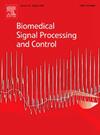Evolution of waveform characteristics in motor imagery among healthy individuals
IF 4.9
2区 医学
Q1 ENGINEERING, BIOMEDICAL
引用次数: 0
Abstract
Motor imagery affects brain activity patterns across frequencies, yet most studies primarily focused on power changes, overlooking intrinsic oscillatory characteristics including waveform nonlinearity and sharpness. To this end, we introduced ensemble empirical mode decomposition (EEMD) to access evolving waveforms, preserving the temporal features of the raw signal across scales. This study used EEG data collected from 20 healthy participants over three consecutive days, randomly assigned to real or sham neurofeedback groups. Each participant completed multiple sessions with or without motor imagery training, and the real-time feedback was based on beta burst detection over the contralateral motor cortex (C3/C4) in the neurofeedback phase. We demonstrated the superiority of EEMD in preserving evolving waveforms of decompositions compared to traditional methods, and systematically compared the degree of nonlinearity, sharpness, and averaged power across frequency bands in motor imagery tasks for healthy individuals. Following neurofeedback training, both the degree of nonlinearity and averaged power in the gamma band exhibited a significant increase, whereas averaged power and sharpness in the low-beta band decreased compared to the no-training condition. The waveform features exhibited an elevated classification performance about power features, improving motor imagery detection accuracies from 76.7% to 82.0%. These findings suggest the significance of waveform characteristics as useful biomarkers alongside average power in identifying motor imagery engagement. The proposed method provides theoretical support for the potential application in motor imagery-related rehabilitation.
健康人运动意象波形特征的演变
运动意象影响不同频率的大脑活动模式,但大多数研究主要集中在功率变化上,忽视了固有的振荡特征,包括波形非线性和清晰度。为此,我们引入了集成经验模态分解(EEMD)来获取不断变化的波形,从而保留了原始信号在不同尺度上的时间特征。这项研究使用了连续三天收集的20名健康参与者的脑电图数据,随机分配到真实或虚假神经反馈组。每个参与者在进行或不进行运动意象训练的情况下完成了多次训练,在神经反馈阶段,实时反馈是基于对侧运动皮层(C3/C4)的β爆发检测。与传统方法相比,我们证明了EEMD在保留分解的演变波形方面的优势,并系统地比较了健康个体运动图像任务中非线性程度、清晰度和各频段平均功率。与未训练相比,经过神经反馈训练后,伽马波段的非线性程度和平均功率均显著增加,而低β波段的平均功率和锐度均下降。波形特征对功率特征的分类性能提高,将运动图像的检测准确率从76.7%提高到82.0%。这些发现表明,波形特征和平均功率在识别运动图像参与方面都是有用的生物标志物。该方法为运动图像相关康复的潜在应用提供了理论支持。
本文章由计算机程序翻译,如有差异,请以英文原文为准。
求助全文
约1分钟内获得全文
求助全文
来源期刊

Biomedical Signal Processing and Control
工程技术-工程:生物医学
CiteScore
9.80
自引率
13.70%
发文量
822
审稿时长
4 months
期刊介绍:
Biomedical Signal Processing and Control aims to provide a cross-disciplinary international forum for the interchange of information on research in the measurement and analysis of signals and images in clinical medicine and the biological sciences. Emphasis is placed on contributions dealing with the practical, applications-led research on the use of methods and devices in clinical diagnosis, patient monitoring and management.
Biomedical Signal Processing and Control reflects the main areas in which these methods are being used and developed at the interface of both engineering and clinical science. The scope of the journal is defined to include relevant review papers, technical notes, short communications and letters. Tutorial papers and special issues will also be published.
 求助内容:
求助内容: 应助结果提醒方式:
应助结果提醒方式:


